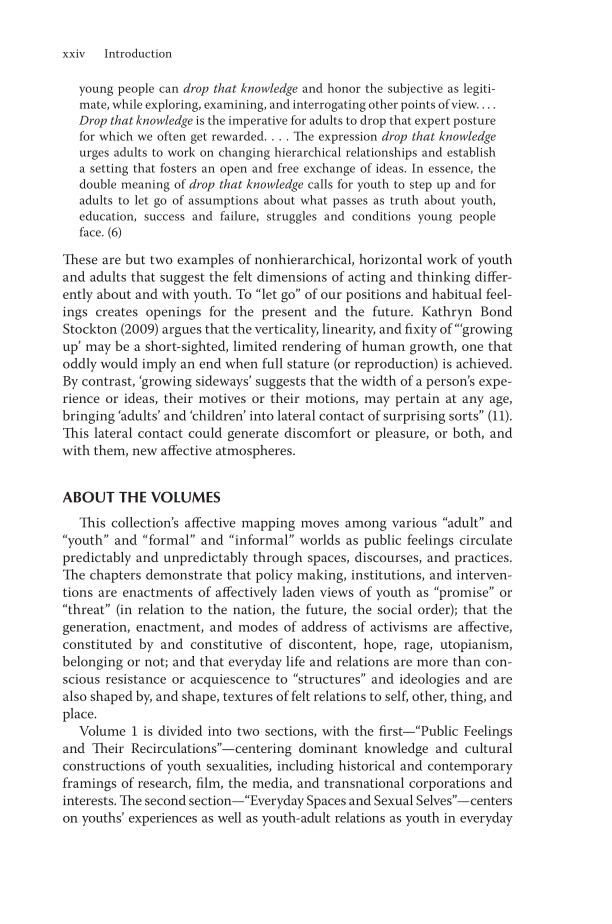xxiv Introduction young people can drop that knowledge and honor the subjective as legiti- mate, while exploring, examining, and interrogating other points of view. . . . Drop that knowledge is the imperative for adults to drop that expert posture for which we often get rewarded. . . . The expression drop that knowledge urges adults to work on changing hierarchical relationships and establish a setting that fosters an open and free exchange of ideas. In essence, the double meaning of drop that knowledge calls for youth to step up and for adults to let go of assumptions about what passes as truth about youth, education, success and failure, struggles and conditions young people face. (6) These are but two examples of nonhierarchical, horizontal work of youth and adults that suggest the felt dimensions of acting and thinking differ- ently about and with youth. To “let go” of our positions and habitual feel- ings creates openings for the present and the future. Kathryn Bond Stockton (2009) argues that the verticality, linearity, and fixity of “‘growing up’ may be a short-sighted, limited rendering of human growth, one that oddly would imply an end when full stature (or reproduction) is achieved. By contrast, ‘growing sideways’ suggests that the width of a person’s expe- rience or ideas, their motives or their motions, may pertain at any age, bringing ‘adults’ and ‘children’ into lateral contact of surprising sorts” (11). This lateral contact could generate discomfort or pleasure, or both, and with them, new affective atmospheres. ABOUT THE VOLUMES This collection’s affective mapping moves among various “adult” and “youth” and “formal” and “informal” worlds as public feelings circulate predictably and unpredictably through spaces, discourses, and practices. The chapters demonstrate that policy making, institutions, and interven- tions are enactments of affectively laden views of youth as “promise” or “threat” (in relation to the nation, the future, the social order) that the generation, enactment, and modes of address of activisms are affective, constituted by and constitutive of discontent, hope, rage, utopianism, belonging or not and that everyday life and relations are more than con- scious resistance or acquiescence to “structures” and ideologies and are also shaped by, and shape, textures of felt relations to self, other, thing, and place. Volume 1 is divided into two sections, with the first—“Public Feelings and Their Recirculations”—centering dominant knowledge and cultural constructions of youth sexualities, including historical and contemporary framings of research, film, the media, and transnational corporations and interests. The second section—“Everyday Spaces and Sexual Selves”—centers on youths’ experiences as well as youth-adult relations as youth in everyday
Document Details My Account Print multiple pages
Print
You have printed 0 times in the last 24 hours.
Your print count will reset on at .
You may print 0 more time(s) before then.
You may print a maximum of 0 pages at a time.
















































































































































































































































































































































































































































































































































































































